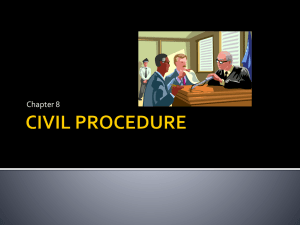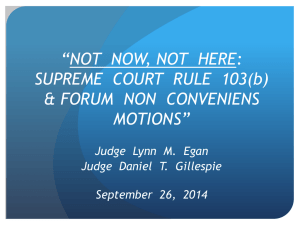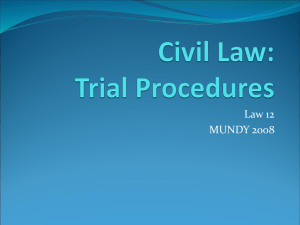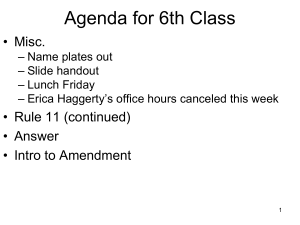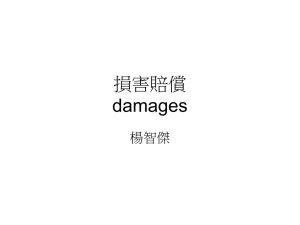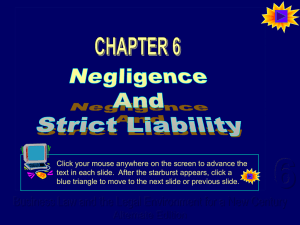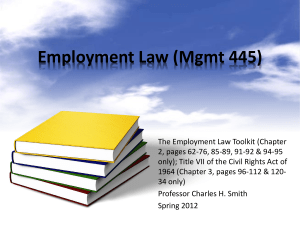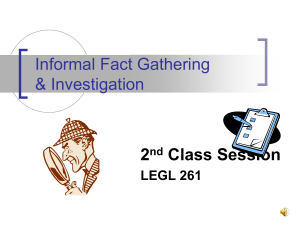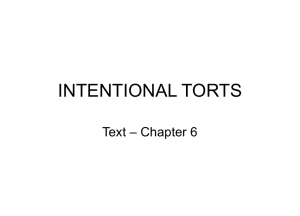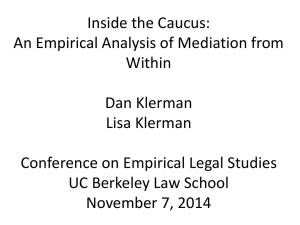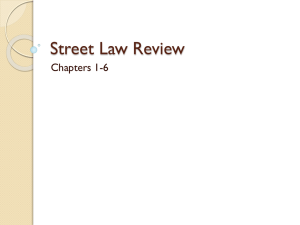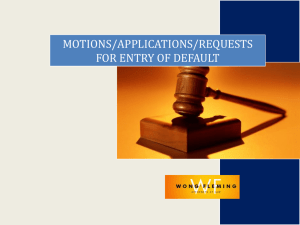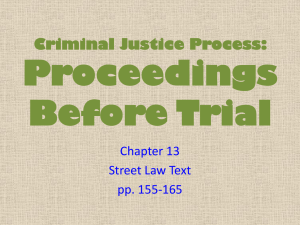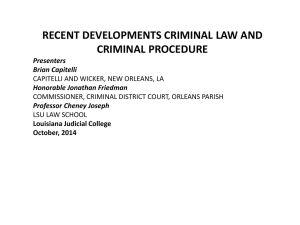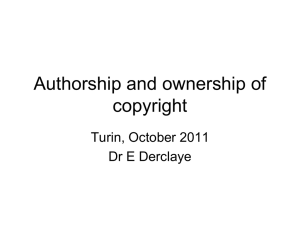Chapter 11 pwrpt
advertisement
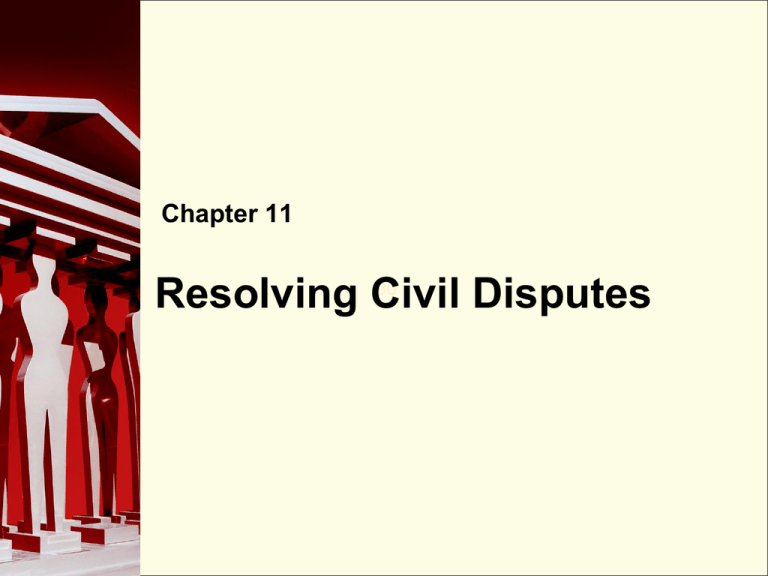
Chapter 11 90 Resolving Civil Disputes Civil Law • Civil law, also known as private law or tort law, regulates disputes between individuals. • The main purpose of criminal law is to punish offenders while protecting society. • The main purpose of civil law is to compensate for harm, usually in90the form of damages - $$$ awarded to a plaintiff for harm, loss, or injury. • Plaintiff: the person or party that initiates the lawsuit. • Defendant: the party that must respond to the lawsuit. Civil Actions • Typical civil actions, or lawsuits, fall under these categories: 1. Tort Law: injuries or harm created by one person to another’s body, reputation, or property; “tort” is derived from a Latin word meaning “twisted” or “wrong.” Family Law: personal disputes that involve marriage, 90 adoption, and support claims. divorce, child custody, Contract Law: failing to fulfill the terms of an agreement, such as non-payment for a service. Labour Law: disputes in the workplace such as wrongful dismissal, unpaid overtime. Property Law: disputes about ownership or maintenance of property. 2. 3. 4. 5. Crimes and Torts • Many crimes can also become torts. If a person is convicted of a crime, the victim does not usually gain from that personally. • In many cases, a person can be sued in addition to being charged. • Example: A person90who is charged with assault may also be sued by the victim for battery. If successful, the victim will receive compensation directly. • Other common examples include – the crime of break and enter = the tort of trespass to land – the crime of theft = the tort of trespass to goods. Civil Courts • Civil actions can become very complex and almost always involve money. • Similar to criminal law, there are different types of civil courts used to hear various civil cases. • Cases that involve large sums of money are 90 supreme court and may be tried in a provincial appealed to a provincial appeal court. Some cases that require important precedents may go the Supreme Court of Canada. • Generally, cases that are relatively minor in nature are heard in small claims court. Small Claims Court • Often referred to as “the people's court,” small claims court resolves civil disputes of $10,000 or less, although some provinces have limits as high as $25,000. • The trial itself is more informal, with the plaintiff and defendant representing themselves. 90 • Both parties present their sides of the story to a judge and do not need to know much about the law as the dispute is usually fairly simple. • Plaintiffs file the paperwork themselves and pay a court fee. The defendant receives a copy of the lawsuit and then a court date is set. Small Claims Actions • Common examples of small claims actions: – breach of contract – minor accidents – damage to property – recovery of property 90 – unpaid bills, loans, rent, or wages • The dollar limit for small claims court ranges from $5000 to $25,000, depending on the province. Balance of Probabilities • In a criminal case, verdicts are based on the concept of beyond a reasonable doubt. • In a civil case, verdicts are based on the balance of probabilities, which means “more probable than not.” • The plaintiff and defendant, also known as the 90 litigants, must convince the judge that their version of the dispute is the correct one. • The judge must then decide which version or story is more believable. • If the plaintiff wins the case, the defendant is liable or responsible; if the defendant wins, he or she is not liable. Filing and Serving a Claim • A plaintiff must begin a lawsuit by filing a statement of claim, which includes: – – – – the plaintiff’s name and address the defendant’s name and address the amount of money or compensation being asked for a brief, clear summary of the reason for the claim 90 paid by the plaintiff and a • A court fee must be copy of the lawsuit is served to the defendant. • A civil action must be filed within a certain time of the incident; this is the limitation period. • The time limit ranges from 2 to 5 years. • A defendant has between 10 and 30 days to respond, depending on the province. A Defendant’s Options • When a defendant is served with a civil action, he or she has a number of options: 1. Accept total responsibility and settle the claim by providing a payment in court or settling out of court. Ignore the claim—if so, a default judgment will be awarded for the plaintiff. 90 File a counterclaim, in which the defendant counters the lawsuit filed against him or her by filing his or her own lawsuit against the plaintiff. Fight the plaintiff’s claim by filing a statement of defence and going to trial. Make a third-party claim, in which the defendant claims a third party is completely or partly responsible for the dispute. 2. 3. 4. 5. Higher Courts • In higher courts with cases that are more complex and involve larger amounts of money, other individuals and mechanisms are brought in to assist the litigants. • In a higher court, it is recommended that the plaintiff and defendant retain counsel (lawyers). 90 • An examination for discovery is a pre-trial process held to learn the evidence that each side intends to present in court. • Similar to disclosure in criminal law, both sides agree to show each other all relevant types of evidence (e.g. documents, photos, files). Civil Trials • Civil actions (outside of small claims court) can be decided by a judge or jury. • In civil court, a jury is comprised of six people. Juries are not often used in civil trials. • The plaintiff presents his or her side of the story first and is followed90by the defendant. • Each party then summarizes, or provides a closing statement, to the judge and/or jury. • A decision can be made to grant all, part, or none of the plaintiff’s claim. Class Action Suits • A class action lawsuit is a single legal action that is brought forward on behalf of several people who share a common grievance. • Example: In recent years, there have been a number of lawsuits against drug manufacturers by people who claim to have suffered side 90 overdoses to illness. effects ranging from • In this kind of situation, all the people who have suffered from a particular drug can sue the drug manufacturer together and can all be named as plaintiffs. • Class action suits put more pressure on defendants and, if successful, often result in higher settlements. Remedies • In private law, compensation is usually provided in the form of damages. There are various types of damages, including: 1. 2. 3. 4. 5. General Special Punitive Aggravated Nominal 90 General Damages • This type of damages cannot be easily or precisely calculated and can be divided into pecuniary and non-pecuniary. • Pecuniary damages: 90 loss of income, future earnings, and cost of specialized future care • Non-pecuniary damages: money awarded for pain and suffering and loss of enjoyment of life (much harder to calculate) • The term pecuniary means “related to money.” Special & Punitive Damages Special Damages • This type of damages is awarded for specific out-of-pocket expenses incurred before the trial. • These include hospital costs and therapy. 90 Punitive Damages • This type of damages is meant to punish the defendant for what is considered to be malicious behaviour. • If the defendant has already been convicted in criminal court for the offence, punitive damages are not usually awarded. Aggravated & Nominal Damages • • • • Aggravated Damages This type of damages is awarded for mental distress and humiliation, or pain and suffering. In Canada, there are limits to how much money a person can receive for pain and suffering. Multi-million dollar lawsuits are more common in the United States. 90 Nominal Damages This type of damages is awarded as a moral victory for the plaintiff. In these cases, the plaintiff has suffered little or no harm, but the judge agrees with his or her reasons for bringing the lawsuit forward. Injunctions • An injunction is a court order that directs a person to avoid doing something for a specific period of time and can be issued as a type of civil remedy. • If a person served with an injunction fails to obey it, he or she may be 90 found in contempt of court and receive a fine or jail sentence. • Examples include staying away from a certain person or limiting certain types of behaviour. Contingency Fees • A contingency fee is an arrangement between a lawyer and a client regarding payment. • Lawyers agree to be paid a certain agreed-upon percentage at the end of the trial or settlement but do not receive money otherwise. • Contingency fees90are common in class action lawsuits or if a person cannot afford a lawyer. • The risk for lawyers is if they do not gain the verdict, they will not receive money for their services—but if they do win, they usually make more money than their standard fees. Enforcing Judgments • When a plaintiff wins a case, it is the plaintiff’s responsibility to collect any damages awarded from the defendant, who must cooperate. • In order for a plaintiff to successfully claim his or her damages, a defendant’s ability to pay is analyzed. This is known as the examination of the debtor. • A defendant must have: 90 – money – assets that can be sold for money – money owed to them that can be redirected to the plaintiff • A defendant may also have his or her wages garnished— a percentage of the defendant’s income is directed at paying the damages, similar to repaying a loan. • If a defendant’s wages are garnished, the court must leave him or her with enough money to live on and provide for any dependants he or she may have. Alternative Dispute Resolution • Also known as ADR, alternative dispute resolution is designed to solve civil disputes without having a formal trial. • Advantages to ADR include: – – – – It is less expensive and faster than going to court. It usually creates less 90 stress on the parties involved. It may result in a better or fairer resolution. It often results in an acceptable compromise that benefits both parties while avoiding the animosity of going to court. • There are three basic ADR models: negotiation, mediation, and arbitration. ADR Models Negotiation: the parties involved try to resolve their dispute directly, with or without lawyers. Mediation: a neutral third party is brought in to help the parties resolve their dispute; a mediator 90 has no actual decision-making power. Arbitration: a neutral third party is brought in to decide the case; an arbitrator’s decisions are binding and final.




